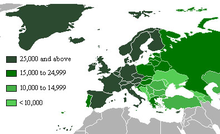See also: International organizations in Europe
European integration is the process of political, legal, economic (and in some cases social and cultural) integration of states wholly or partially in Europe. In the present day, European integration has primarily come about through the Council of Europe andEuropean Union in Western and Central Europe andCommonwealth of Independent States in Eastern Europe and most of former Soviet countries.
Economy
Main article: Economy of Europe
As a continent, the economy of Europe is currently the largest on Earth and it is the richest region as measured by assets under management with over $32.7 trillion compared to North America's $27.1 trillion in 2008.[152] In 2009 Europe remained the wealthiest region. Its $37.1 trillion in assets under management represented one-third of the world’s wealth. It was one of several regions where wealth surpassed its precrisis year-end peak.[153] As with other continents, Europe has a large variation of wealth among its countries. The richer states tend to be in the West; some of theEastern economies are still emerging from the collapse of the Soviet Union and Yugoslavia.
The European Union, an intergovernmental body composed of 27 European states, comprises thelargest single economic area in the world. Currently, 16 EU countries share the euro as a common currency. Five European countries rank in the top ten of the worlds largest national economies in GDP (PPP). This includes (ranks according to the CIA): Germany (5), the UK (6), Russia (7), France (8), and Italy (10).[154]
Pre–1945: Industrial growth
Capitalism has been dominant in the Western world since the end of feudalism.[155] From Britain, it gradually spread throughout Europe.[156]The Industrial Revolution started in Europe, specifically the United Kingdom in the late 18th century,[157] and the 19th century saw Western Europe industrialise. Economies were disrupted by World War I but by the beginning of World War II they had recovered and were having to compete with the growing economic strength of the United States. World War II, again, damaged much of Europe's industries.
1945–1990: The Cold War
After World War II the economy of the UK was in a state of ruin,[158] and continued to suffer relative economic decline in the following decades.[159] Italy was also in a poor economic condition but regained a high level of growth by the 1950s. West Germany recovered quickly and had doubled production from pre-war levels by the 1950s.[160] France also staged a remarkable comeback enjoying rapid growth and modernisation; later on Spain, under the leadership ofFranco, also recovered, and the nation recorded huge unprecedented economic growth beginning in the 1960s in what is called the Spanish miracle.[161] The majority of Eastern European states came under the control of the USSR and thus were members of the Council for Mutual Economic Assistance (COMECON).[162]
The states which retained a free-market system were given a large amount of aid by the United States under the Marshall Plan.[163] The western states moved to link their economies together, providing the basis for the EU and increasing cross border trade. This helped them to enjoy rapidly improving economies, while those states in COMECON were struggling in a large part due to the cost of the Cold War. Until 1990, theEuropean Community was expanded from 6 founding members to 12. The emphasis placed on resurrecting the West German economy led to it overtaking the UK as Europe's largest economy.
1991–2007: Integration and reunification
With the fall of communism in Eastern Europe in 1991 the Eastern states had to adapt to a free market system. There were varying degrees of success with Central European countries such as Poland, Hungary, and Slovenia adapting reasonably quickly, while eastern states likeUkraine and Russia taking far longer. Western Europe helped Eastern Europe by forming economic ties with it.[citation needed]
After East and West Germany were reunited in 1990, the economy of West Germany struggled as it had to support and largely rebuild the infrastructure of East Germany. Yugoslavia lagged farthest behind as it was ravaged by war and in 2003 there were still many EU and NATOpeacekeeping troops in Kosovo, the Republic of Macedonia, and Bosnia and Herzegovina, with only Slovenia making any real progress.
By the millennium change, the EU dominated the economy of Europe comprising the five largest European economies of the time namely Germany, the United Kingdom, France, Italy, and Spain. In 1999 12 of the 15 members of the EU joined the Eurozone replacing their former national currencies by the common euro. The three who chose to remain outside the Eurozone were: the United Kingdom, Denmark, and Sweden.
2008–2010: Recession
| This article or section may be slanted towards recent events. Please try to keep recent events in historical perspective. (May 2010) |
Main article: Late 2000s recession in Europe
The Eurozone entered its first official recession in the third quarter of 2008, official figures confirmed in January 2009.[164] While beginning in the United States the late-2000s recession spread to Europe rapidly and has affected much of the region.[165] The official unemployment rate in the 16 countries that use the euro rose to 9.5% in May 2009.[166] Europe's young workers have been especially hard hit.[167] In the first quarter of 2009, the unemployment rate in the EU27 for those aged 15–24 was 18.3%.[168]
In early 2010 fears of a sovereign debt crisis[169] developed concerning some countries in Europe, especially Greece, Ireland, Spain, and Portugal.[170] As a resul



No comments:
Post a Comment